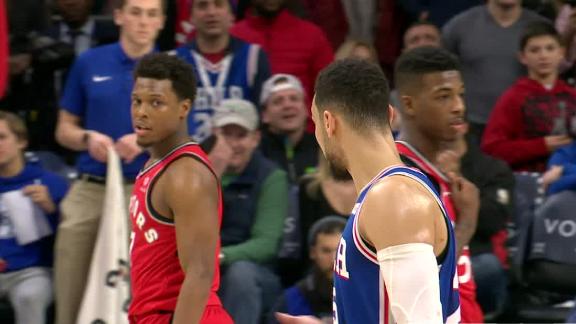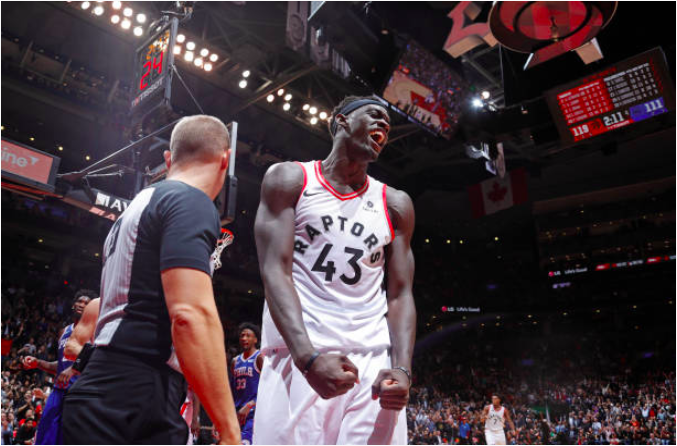The Toronto Raptors were coyly playing the part of the magician after their 129-112 victory over the Philadelphia 76ers, insisting observers not look at the obvious. Players downplayed their offensive excellence, almost bashful at the concept that 129 points scored might be notable. Asked how the team handled Philadelphia’s defensive length – only a night after being flustered by the Milwaukee Bucks’ length – Nurse didn’t even mention the team’s offence.
“We talked about this before the game, too, we got some stops tonight,” said Nurse after the win. “A lot of them, some deflections, some rebounds. We kept them under 42 percent, I think that’s six out of eight if not seven out of eight games we’ve [held teams to a] field goal percentage under 42, so that’s going to fuel our offence much better than last night, when we were watching it go through the net and had to take it out. That was probably the biggest thing [that fueled our scoring].”
Players agreed whole-heartedly. When asked how the Raptors scored so many more points against Philadelphia, despite attempting far fewer 3s than against Milwaukee, Pascal Siakam said, “I think we got stops.”
Danny Green, too, discussed defence when asked about the offence. “We want to be aggressive. If you get stops, you get out in transition. If you get steals, you get out in transition even better. We know our best offence is getting out in transition, so our defence has to be well in order to do so.”
Were they trying to pull the wool over our eyes? It turned out unanimity was a sign of an intentional strategic focus. Transition is indeed the Raptors’ best offence, and their 1.16 points per possessions in transition has been more efficient than in almost any other situation. Kawhi Leonard and Siakam have been incredible on the fast-break, scoring at will. Against Philadelphia, they combined for 12 points in transition, including these majestic Siakam-to-Leonard and Leonard-to-Siakam opuses.
“I love it,” said Siakam of the transition game. “I mean, I like to run so whenever we can get stops and run I think that’s a better game for all of us. So the more we can do that the better we look.”
Toronto won the fast-break battle 27-12, which proved to just about be the difference in the game. The possession battle was equal, with Toronto’s 92 shots slightly more than Philadelphia’s 91. While Toronto won the turnover game, forcing 23 and only committing 15, Philadelphia dominated on the offensive glass, 17-9. When both teams attempt the same number of shots, getting easier looks is the most important factor. That’s where transition scoring won the game for Toronto.
Toronto’s half-court offence alone wasn’t enough to set the world on fire. Toronto only managed 103.4 points per play against Philadelphia in the half-court, but their scoring jumped to 133.3 points per play in transition. Nurse, Siakam, and Green had it right; defence was quietly the team’s best source of offence.
The defence itself, on the other hand, was anything but quiet. Ben Simmons committed 11 turnovers, and Kawhi Leonard unassumingly took the ball from him on four separate occasions.
Much like Leonard himself, Toronto’s defensive stringency wasn’t present against Milwaukee. The Raptors only managed 11 fast-break points, because Milwaukee shot a fiery 48.9 percent from the field. Milwaukee guards had easy lanes to an unprotected rim, and Milwaukee shooters nailed 19 triples. Toronto’s 13 deflections (they had 19 against Philadelphia) weren’t enough to jumpstart their transition game.
Furthermore, Milwaukee actively sought to limit Toronto’s transition opportunities. The Bucks only recorded eight offensive rebounds against the Raptors. Though they are one of the longest teams in the league, starting a gigantic lineup even without Giannis Antetokounmpo, they basically ignored the offensive glass and focused on limiting Toronto’s transition opportunities. The result was that would-be fast-breaks were stymied before they even began; watch here, as Milwaukee already has all of their players at half-court and ready to defend before Kyle Lowry even crosses his own free-throw line.
Compare that to a Leonard-led fast-break bucket against Philadelphia. Three Sixers hang around the rim, lurking for potential rebounding opportunities. Eventually, Toronto corrals the ball, and Leonard scores in transition by himself. Though Philly defenders eventually make it back to their own side of the court, they aren’t ready for help responsibilities when Leonard smoothly beats his initial defender.
It wasn’t exclusively fast-break baskets that allowed Toronto to score more against Philadelphia than Milwaukee. Of course, Kawhi Leonard returned to the lineup. His 34 minutes of playing time, 19 shot attempts, and 50 touches were leeched from Norman Powell (who lost 13 minutes and 7 touches) and Lorenzo Brown (who lost 15 minutes and 45 touches). There’s a dramatic leap in skill, both offensively and defensively, from Powell or Brown to Leonard.
More than that though, Toronto’s offence was more diverse. Milwaukee’s defenders used their length to stay at home against the pick-and-roll. Wings only dug into the gap half-heartedly, more concerned with denying potential passes to shooters. Bucks’ guards went over the pick to take away Lowry’s pull-up jumper, and centers dropped back to contest any shots at the rim.
The result was that Toronto’s screeners romped through wide-open pastures available for jumpers. Serge Ibaka and Siakam both scored the most points of their Raptors’ careers against Milwaukee.
The midrange was the meat and potatoes of the Raptors’ offence against Milwaukee. The Bucks used their length to stymie the Raptors preferred options, and it also helped that Toronto shot an uncharacteristic 9-for-45 from deep.
Toronto diversified their offence against Philadelphia, playing faster and improvising more. Instead of forcing all of his passes to the roller in the midrange, Lowry would keep his dribble and find cutters from the weak side. Once when Lowry did pass to the roller, a Leonard back-screen on Ibaka’s defender turned the play into a Spain pick-and-roll, which freed Ibaka for a far easier shot. A night after Lowry threw seven assists to the screener out of pick-and-roll actions, only three of his assists came in the same variety against Philadelphia.
Instead, offence came from other areas. In one unscripted moment, Green even found himself in the post:
“I was a little more involved with handling a little more, actually handling in the post once or twice, which is rare for me,” said Green after the game. “It’s rare, because I don’t get the ball in the post, so drawing a double-team is rare. But they made me look good. Pascal cut with some purpose, and he was wide-open, an open dunk.”
Toronto’s diversified offence actually resulted in fewer attempted triples than their cluttered offence of the Milwaukee game. The Raptors attempted a tied season-low 27 against Philly; however, they made 11, shooting 40.7 percent as a team. The marksman Green was emblematic of the team, finishing with as many assists, 4, as attempted 3s. The veteran has played in 548 games, but he’s only dished four assists or more in 50 games.
Milwaukee and Philadelphia are two of the longest teams in the league, and they both boast tenacious defences. In fact, a year after Philadelphia led the league in half-court defence, Milwaukee is doing the same in 2018-19. It took a humiliating loss for Toronto to learn its lessons, but they bounced back only 24 hours later.
A number of interlocking factors boost Toronto’s offence to its peak. Players need to be fast and decisive. Variation is important, and Toronto can’t just rely on vanilla pick-and-rolls to manufacture easy baskets. Toronto’s best players in Lowry, Leonard, and Siakam need to be on the floor. When those three play together, Toronto averages a ridiculous 125.7 points per 100 possessions, which is more than the Warriors score with Steph Curry, Klay Thompson, and Kevin Durant on the floor.
However, none of the above factors were topics of public discussion for Toronto’s players and staff before or after beating Philadelphia. After being devoured by Milwaukee’s shooting, it was Toronto’s vaunted defence that prompted an offensive explosion in their next game. Forcing misses is good. Stealing the ball is even better. The offence will take care of itself.
If you stare at the Raptors’ magical performance for long, the obvious trick reveals itself: when it came to the Raptors’ scoring totals in both games, the offensive performances were paradoxically diminished in importance next to the team defence. The Raptors happily explained the trick when asked. Like any magician worth his salt, they were telling the truth the whole time. For the rest of us to understand, we just had to look a little closer.



